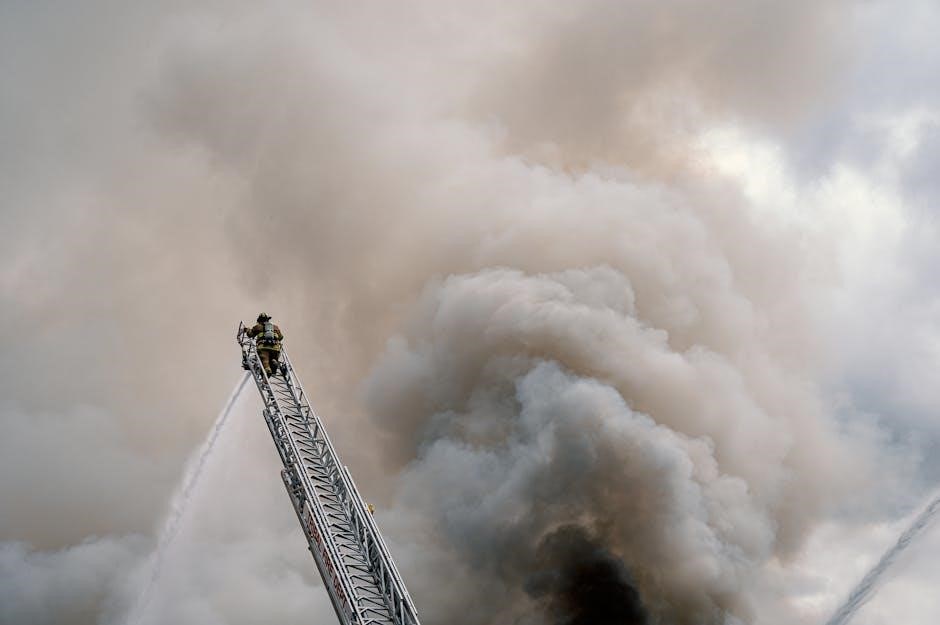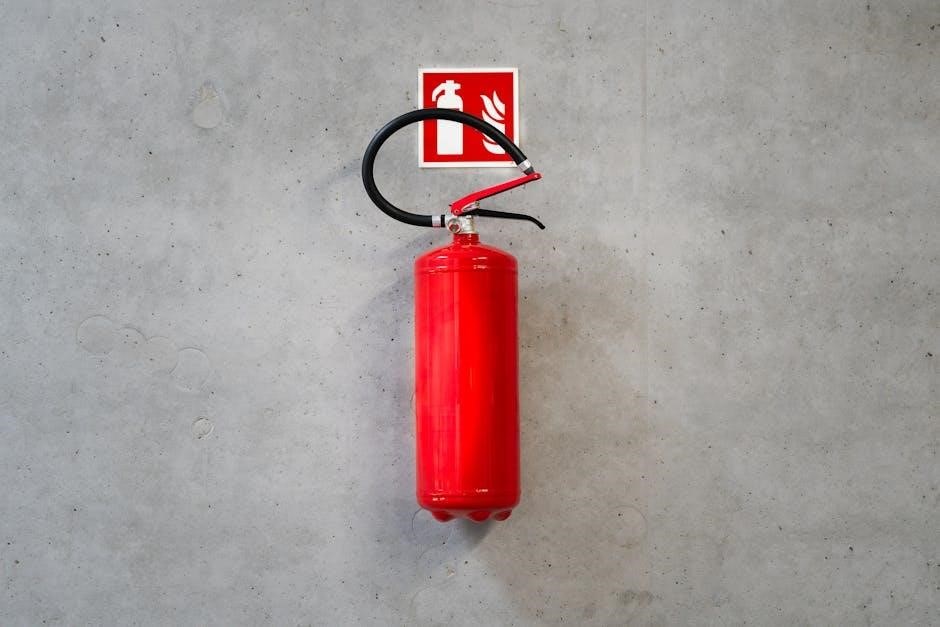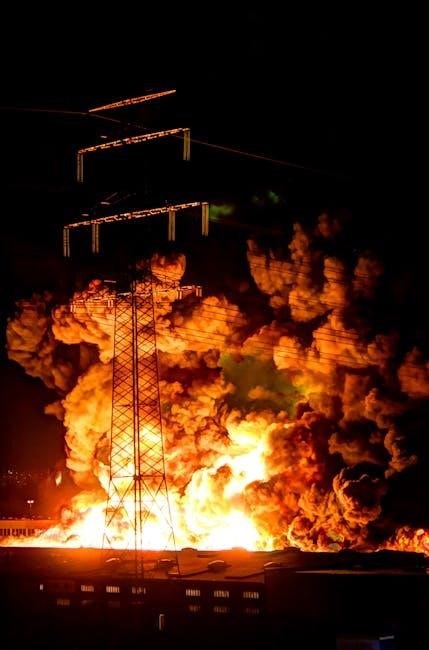
fire protection guide to hazardous materials
Hazardous materials pose significant risks due to their flammable, toxic, or reactive properties, requiring specialized fire protection strategies to prevent incidents and safeguard lives and the environment.
1.1. Definition and Classification of Hazardous Materials
Hazardous materials are substances that pose risks to health, safety, or the environment due to their flammable, toxic, reactive, or corrosive properties. Classification is based on physical and chemical characteristics, such as flash point, auto-ignition temperature, and reactivity; NFPA 704 provides a standardized system for identifying and labeling hazardous materials using a diamond-shaped placard with numerical ratings for flammability, health, and reactivity hazards.
1.2. Importance of Fire Protection in Handling Hazardous Materials
Fire protection is critical in managing hazardous materials to prevent catastrophic incidents. It ensures the safety of personnel, facilities, and the environment by mitigating risks associated with flammable, toxic, or reactive substances. Effective fire protection measures, such as proper storage and suppression systems, are essential to prevent ignition and control potential fires, safeguarding against devastating consequences.

Understanding Fire Risks Associated with Hazardous Materials
Identifying ignition sources and flammable properties is crucial to assessing fire risks. Managing risks involves understanding the fire triangle and implementing strategies to control fuel, oxygen, and heat.
2.1. Identifying Ignition Sources and Flammable Properties
Identifying ignition sources, such as sparks, open flames, or hot surfaces, is critical. Flammable properties like flash points and explosive limits determine fire risks. Understanding these factors helps prevent accidental fires and ensures proper mitigation strategies are in place to control hazardous material-related fires effectively.
2.2. Understanding the Fire Triangle (Fuel, Oxygen, Heat)
The fire triangle consists of three essential elements: fuel, oxygen, and heat. Fuel provides the material needed for combustion, oxygen supports the chemical reaction, and heat initiates the ignition. Understanding these components is crucial for effective fire prevention strategies. By removing or controlling one or more of these elements, fires can be prevented or mitigated in environments handling hazardous materials.

NFPA Standards for Hazardous Materials
NFPA standards provide critical guidelines for managing hazardous materials, ensuring safety through proper handling, storage, and emergency response. These documents are essential for compliance and risk mitigation.
3.1. Overview of Key NFPA Documents (NFPA 49, 325, 491, 704)
These documents provide detailed guidance on hazardous materials. NFPA 49 covers chemical hazards, NFPA 325 focuses on fire hazard properties, NFPA 491 details requirements for fire hazard assessment, and NFPA 704 establishes the standard for identifying hazardous materials through diamond labels, ensuring clear communication of risks for safe handling and emergency response.
3.2. Role of NFPA 704 in Identifying Hazardous Properties
NFPA 704 provides a standardized system for identifying hazardous materials using a diamond label. Each section of the diamond represents specific hazards: flammability (red), health (blue), instability (yellow), and special hazards (white). This system helps emergency responders quickly assess risks and take appropriate actions, ensuring safer handling and mitigation of hazardous material incidents.

Risk Assessment and Management
Risk assessment identifies potential hazards and evaluates their likelihood and impact, enabling proactive measures to mitigate fire risks and ensure the safety of people, environment, and infrastructure.
4.1. Conducting a Fire Risk Assessment for Hazardous Materials
A fire risk assessment evaluates hazards posed by hazardous materials, identifying ignition sources, flammable properties, and potential risks. It considers the fire triangle elements—fuel, oxygen, and heat—and assesses mitigation strategies, such as inherent safety principles and fire suppression systems, to minimize risks and ensure safe handling and storage of hazardous materials.
4.2. Strategies for Mitigating Fire Risks
Effective mitigation involves removing or reducing elements of the fire triangle—fuel, oxygen, or heat. This includes using fire-resistant materials, proper ventilation, and fire suppression systems. Inherent safety principles, such as minimizing chemical quantities and using less hazardous alternatives, also play a crucial role in reducing risks associated with hazardous materials.

Fire Prevention and Safety Measures
Implementing comprehensive fire prevention strategies ensures the safety of personnel, facilities, and the environment from hazardous material fires through proactive risk management and adherence to safety protocols.
5.1. Passive Fire Protection (Fire-Resistant Materials, Containment)
Passive fire protection involves using fire-resistant materials and containment systems to prevent fire spread and protect structures. Fire-resistant walls, floors, and doors act as barriers, while containment systems like spill berms and secondary containment prevent hazardous material leaks. These measures delay fire spread, allowing evacuation and emergency response, ensuring compliance with NFPA standards for safer environments.
5.2. Active Fire Protection (Fire Suppression Systems, Alarms)
Active fire protection employs systems like fire suppression, alarms, and detection to mitigate hazards. Fire suppression systems, such as clean agent or carbon dioxide, extinguish fires in hazardous material areas. Early detection through smoke and heat sensors triggers alarms, enabling quick evacuation and response. These systems are critical for minimizing fire escalation and ensuring timely intervention, aligning with NFPA standards for enhanced safety.
Emergency Response Planning
Effective emergency response planning is crucial for mitigating hazardous material incidents. It involves developing strategies for rapid response, evacuation, and coordination with firefighting teams to ensure safety and minimize damage.
6.1. Developing an Emergency Response Plan for Hazardous Materials Incidents
Developing a comprehensive emergency response plan involves identifying potential risks, outlining evacuation procedures, and establishing communication protocols. It ensures coordination between firefighters, rescue teams, and stakeholders to effectively manage hazardous material incidents, minimizing harm to people and the environment while ensuring compliance with safety regulations and standards.
6.2. Training and Preparedness for Firefighters and Personnel
Firefighters and personnel require specialized training to handle hazardous material fires, including strategies for containment, evacuation, and suppression. Regular drills and simulations ensure preparedness, while updated protocols and equipment familiarization enhance response effectiveness. Training emphasizes risk assessment and real-time decision-making to safeguard both responders and affected communities during incidents.
Safe Handling and Storage of Hazardous Materials
Proper handling and storage of hazardous materials require understanding their properties, using appropriate equipment, and adhering to safety protocols to minimize risks and prevent accidents.
7.1. Proper Handling Techniques to Prevent Accidents
Safe handling of hazardous materials involves using personal protective equipment, following established protocols, and ensuring proper labeling and containment. Training and adherence to safety guidelines are crucial to prevent spills, leaks, and fires, protecting both personnel and the environment from potential hazards.
7.2. Storage Requirements for Flammable and Combustible Materials
Proper storage of flammable and combustible materials requires approved containers, well-ventilated areas, and compliance with NFPA standards. Materials should be kept away from ignition sources and heat, with clear labeling and segregation from incompatible substances to minimize fire risks and ensure safe conditions.

Regulatory Compliance and Safety Standards
Adhering to regulations like OSHA, EPA, and DOT ensures safe handling of hazardous materials, preventing incidents and promoting a compliant, secure environment for all stakeholders involved.
8.1. Overview of Key Regulations (OSHA, EPA, DOT)
OSHA ensures workplace safety through hazard communication and training. EPA regulates environmental impacts, including storage and disposal. DOT oversees transportation safety, requiring proper labeling and packaging. Compliance with these regulations is critical for minimizing risks and ensuring legal adherence in handling hazardous materials.
8.2. Importance of Adhering to Safety Standards
Adhering to safety standards ensures compliance with legal requirements, minimizes fire risks, and protects people and the environment. These standards provide proven practices to handle hazardous materials safely, preventing incidents and ensuring operational integrity. Compliance also enhances workplace safety culture and avoids legal penalties, making it a critical component of responsible hazardous material management.

Case Studies and Lessons Learned
Case studies highlight real-world incidents involving hazardous materials fires, offering valuable insights into causes, consequences, and prevention strategies. These lessons enhance safety measures and inform future practices.
9.1. Notable Incidents Involving Hazardous Materials Fires
Notable incidents, such as the 1976 H.D. Branion fire and others, highlight the devastating consequences of hazardous material fires. These events often involve chemical spills, improper storage, or ignition sources, leading to loss of life and environmental damage. Analyzing these cases provides critical lessons for improving safety protocols and regulatory compliance.
9.2. Key Lessons for Improving Fire Protection Practices
Incidents involving hazardous materials fires underscore the importance of adhering to NFPA standards, conducting thorough risk assessments, and implementing robust emergency response plans. Controlling ignition sources, proper material storage, and prompt suppression systems are critical. Training personnel and adopting inherent safety principles can mitigate risks and prevent future disasters, ensuring safer handling and reduced environmental impact.
Community and Environmental Impact
Hazardous material fires pose significant risks to communities and the environment, necessitating strict fire protection measures to prevent fatalities, injuries, and environmental contamination.
10.1. Protecting People and the Environment from Hazardous Material Fires
Effective fire protection strategies are essential to safeguard communities and ecosystems from hazardous material fires, ensuring minimal risk to human health and environmental contamination through prevention, mitigation, and rapid response measures.
10.2. Public Awareness and Education on Fire Safety
Public awareness and education are critical in preventing hazardous material fires. Community outreach programs, safety workshops, and accessible resources empower individuals to recognize risks and respond effectively. Educating the public on emergency procedures and the importance of compliance with safety standards fosters a proactive approach to fire safety, reducing potential hazards and enhancing community resilience.

Advanced Technologies in Fire Protection
Advanced technologies like smart sensors, automated suppression systems, and fire-resistant materials enhance fire protection, offering real-time monitoring and efficient mitigation of hazardous material fires.
11.1. Use of Inherent Safety Principles in Fire Protection
Inherent safety principles focus on designing systems to minimize hazards, reducing the risk of fire by eliminating ignition sources and using fire-resistant materials. This proactive approach ensures safer handling of hazardous materials, preventing incidents through robust containment and process design. By integrating these principles, facilities achieve long-term safety and environmental protection.
11.2. Emerging Technologies for Hazardous Material Fire Mitigation
Emerging technologies, such as advanced sensors, IoT-enabled monitoring systems, and AI-driven predictive analytics, are revolutionizing fire mitigation for hazardous materials. These tools enable real-time detection of risks, early intervention, and smarter suppression systems. Innovations like nanotechnology-based fire-resistant materials and clean agent systems further enhance safety, minimizing environmental impact while protecting people and assets from hazardous material fires.

Training and Certification Programs
Specialized training is crucial for handling hazardous materials safely, ensuring compliance with regulations and minimizing risks. Certification programs for fire safety professionals enhance expertise and maintain high standards.
12.1. Importance of Specialized Training for Handling Hazardous Materials
Specialized training is essential for safely managing hazardous materials, preventing accidents, and ensuring compliance with safety standards. It equips personnel with the knowledge and skills to handle emergencies effectively, reducing risks to people, the environment, and facilities. Proper training also fosters a culture of safety and preparedness, which is critical in high-risk environments.
12.2. Certification Programs for Fire Safety Professionals
Certification programs for fire safety professionals ensure they meet recognized standards in hazardous materials management. These programs, often aligned with NFPA guidelines, provide comprehensive training and validate expertise in fire protection, emergency response, and regulatory compliance. Certification enhances professionalism, reduces risks, and ensures adherence to safety laws, making it a critical component of modern fire safety practices.
Effective fire protection strategies combined with emerging technologies will drive future advancements, ensuring safer handling of hazardous materials and mitigating potential risks more efficiently.
13.1. Summary of Key Fire Protection Strategies
The identification of hazardous materials and their properties is crucial for effective fire protection. Strategies include removing heat, oxygen, or fuel sources, proper storage, and using fire-resistant materials. Active suppression systems and alarms are essential. Training, emergency planning, and adherence to NFPA standards ensure comprehensive safety and mitigate risks effectively in hazardous environments.
13.2. Future Trends in Hazardous Material Fire Safety
Emerging technologies like advanced fire detection systems, smart sensors, and AI-driven risk assessment tools will revolutionize hazardous material fire safety. Improved fire-resistant materials and eco-friendly suppression agents are expected to reduce environmental impacts. Enhanced international collaboration and data-sharing initiatives will further refine safety protocols, ensuring a proactive approach to mitigating fire risks in the future.